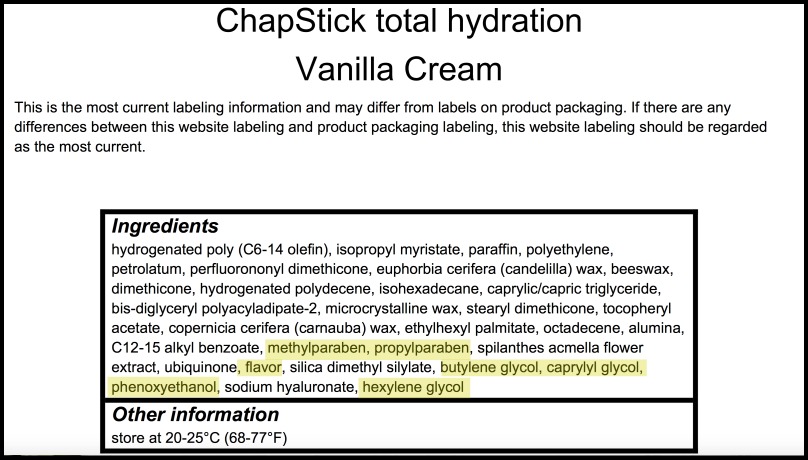
(Recipe Below)
My kids have been asking me to make chapstick again, so I figured why not do a quick post on it and why I’m not a fan of conventional, store-bought chapsticks? Plus, I figured I’d share my simple 4-ingredient DIY recipe!
Now before you stop reading there because it sounds pretty daunting (I always thought so, too!), I promise it’s almost easier than making a grilled cheese sandwich. Not sure what exactly to compare it too, but it is about as quick and easy as that!
But before I get to the full recipe, there are quite a few reasons why I’m not a fan of regular chapsticks.
Here are just a few of the many ingredients in conventional chapsticks, and their health effects:
Paraffin:
• Ethylene oxide contamination(known cancer-causer)
• Possible 1,4 dioxane contamination (probable human carcinogen)
Phenoxyethanol:
• Ethylene glycol and possible 1,4 dioxane contamination
• Allergic reactions
• Several animal studies have shown toxicity to the brain and nervous system
• The FDA has stated in a press release that it “can depress the central nervous system and may cause vomiting and diarrhea”
• The European Union considers it to be toxic in products used in the mouth area
Glycols:
• Used as solvents and moisturizers in cosmetics.
• Solvents have been shown to be toxic to the brain and nervous system, and are known as “brain drainers.”
• Hexylene glycol, one of the glycols in this chapstick, may penetrate the skin easily, and a study has shown that it is slightly toxic after application to intact skin. The target tissues include the central nervous system (the brain and nerves), kidneys, and lungs.
• New Jersey’s Department of Health and Senior Services’ Hazardous Substance Fact Sheet on hexylene glycol states that “this chemical has not been adequately evaluated to determine whether brain or other nerve damage could occur with repeated exposure. However, many solvents and other petroleum-based chemicals have been show to cause such damage.”
Flavor:
• Not sure what is in this one!
• Flavor is one of those ingredients that is considered to be proprietary, so manufacturers are not required to list the (usually) many ingredients typically contained in the word “flavor.”
Parabens (this chapstick has 2 types listed!):
• Act as strong endocrine disruptors
• Have also been found in the tissue of biopsied breast cancer tumors
• Can cause allergic reactions such as contact dermatitis
• Linked to fertility problems
Why are endocrine disruptors and these other toxins in our chapstick in our chapstick in the first place? They are not only absorbed into the skin, but they can also be ingested include endocrine disruptors
What are endocrine disruptors?
The quick answer is that endocrine disruptors are basically “hormone disruptors.” They are man-made chemicals that can either imitate or get in the way of our body’s natural hormones, which interferes with them doing their job.
Hormones are our body’s chemical messengers, and the endocrine system controls every function of our body. You can see that if there is a synthetic chemical imitating or preventing our body’s own messengers from doing what they are supposed to, so many different health issues can crop up.
Endocrine disruptors is linked to obesity, diabetes, reproductive issues and fertility problems, cardiovascular disease, neurodevelopmental disorders (such as autism or ADHD), autoimmune disorders, allergy issues, and many more.
So while manufacturers will say that these harmful ingredients are in tiny quantities that are under the safe limits (which may or may not be true) in these products, there are still some issues with that.
For example, what if we use several products that contain some of these toxins? Do we get double, triple, or even quadruple the exposure, which then makes it a more toxic amount?
And even worse, no one knows the health effects of how these toxins work synergistically, meaning what happens when they’re combined. What happens when phenoxyethanol and parabens are used together, and are used in multiple products, several times a day? No one knows.

Source: Chapstick website
So in a nutshell, these are just a few of the reasons I choose to make my own.
Here’s how to do it:
DIY Chapstick Recipe
Here’s what you’ll need:
Equipment
Double boiler*
Pipettes for pouring (2 options: glass or plastic – I prefer the glass)
Chapstick tubes
*Can also add water to a larger pot and place a smaller pot on top if you don’t have a double boiler
Ingredients
2 Tbsp Organic Coconut Oil
1 Tbsp Shea Butter
3 tsp Beeswax
1 drop Vitamin E Oil
Optional, but recommended: essential oil, such as Peppermint
Directions
- Melt the coconut oil, shea butter, and beeswax over low heat in the double boiler, stir frequently.
- Remove from heat and add essential oil, and 1-2 drops Vitamin E oil
- Whisk together quickly, before it hardens
- Use the pipettes to pour mixture into chapstick tubes
- Put them into the fridge to cool and harden when finished.
Makes approximately 15 tubes.
Want to see me make this exact recipe? Watch the video on my Facebook page.
Safer Brands of Chapstick
Eco Lips (also available on Amazon and in stores)
Green Envee
Dr. Bronner’s (also available on Amazon and in stores)
Sources
Concentrations of Parabens in Human Breast Cancer Tumors
New Jersey’s Department of Health and Senior Services’ Hazardous Substance Fact Sheet: Hexylene Glycol
The Toxins That Threaten Our Brains
The Dermatology Review: Phenoxyethanol

